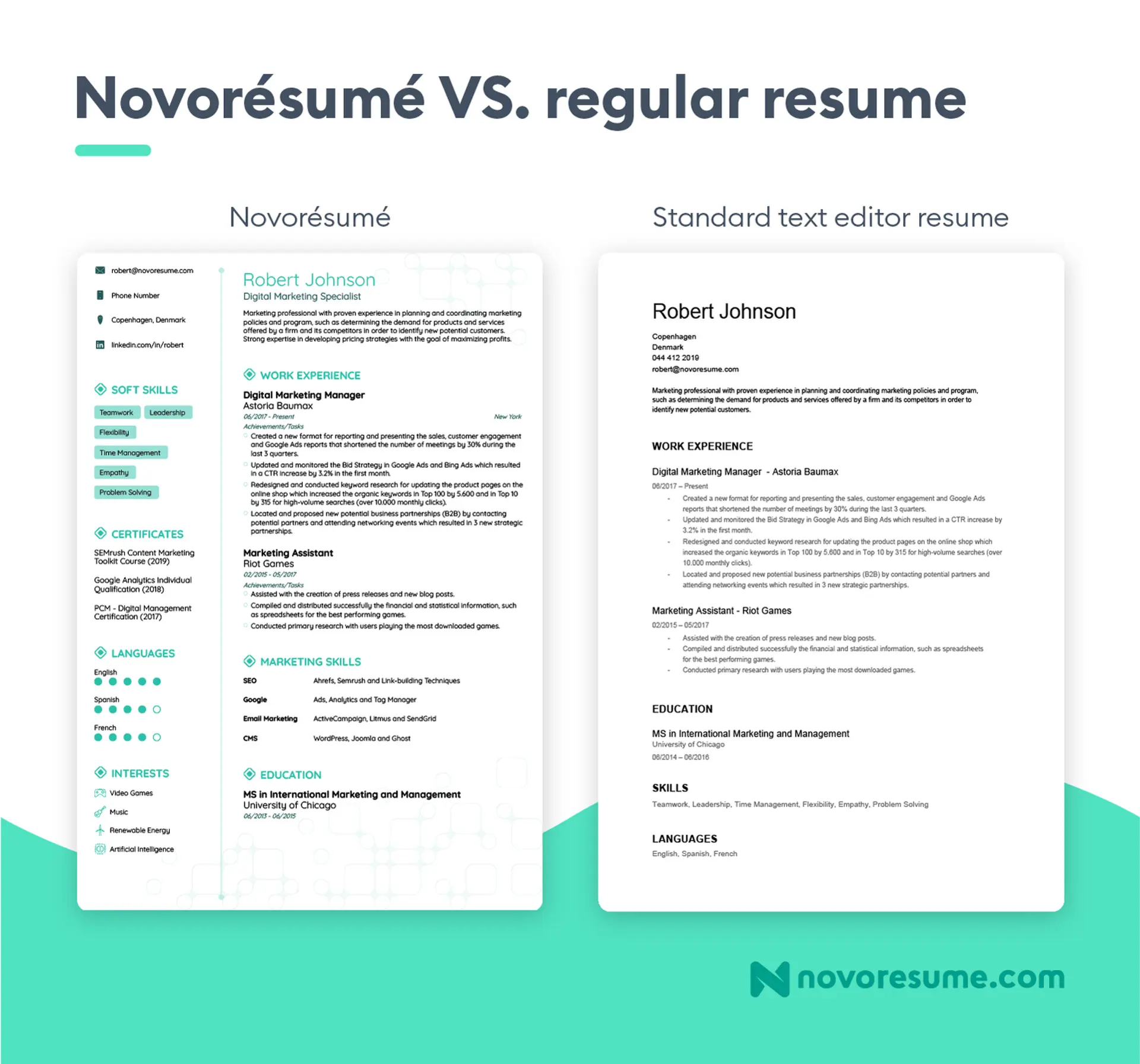
No matter how much time you spend perfecting your resume, the truth is that it only takes a few seconds to make an impression.
And by a few, we mean less than ten seconds.
It’s a brutal reality, but it’s true - even the most qualified candidates can get overlooked if they don’t follow the ten-second resume rule.
But don't panic!
Ten seconds doesn’t seem like a lot of time but if you learn the ins and outs of the ten-second resume rule, you can make it work for you.
In this article, we’re going to cover:
- What Is the Ten-Second Resume Rule?
- 5 Tips to Apply the Ten-Second Resume Rule
- 4 Crucial Resume Mistakes to Avoid
…and more!
Ready to make every second count? Let's dive in!
What Is the 10-Second Resume Rule?
The ten-second rule is a concept you might have heard of during your job hunt.
The idea is that your resume needs to make an impression on a hiring manager in less than ten seconds if you want to get the job.
This is because hiring managers spend an average of six seconds skimming through your resume before deciding if it’s worth reading in detail.
You might be wondering how they could make a decision like that so quickly.
The thing is, most hiring managers these days are swarmed with hundreds of resumes per job opening. So, instead of going through piles of candidates in detail, they skim through every application and only read the resumes that grab their attention.
And your job is to do just that.
This is where the ten-second resume rule comes in - you need to make sure your resume stands out and shows the hiring manager what they want to see right away.
5 Tips to Apply the 10-Second Resume Rule
Now that you know what the ten-second resume rule is, let’s talk about how you can actually apply it to your resume.
We’ve divided the process into several tips you should keep in mind when creating your resume.
Let’s get started!
#1. Stick to One Page
When it comes to how long your resume should be, less is more.
Your resume only needs to give the hiring manager a concise snapshot of your professional life, not your whole life story. So, try to keep everything on a single page.
Hiring managers don't have time to flip through several pages to see if you have what it takes at a glance.
In fact, if your resume is two pages or more, they’re likely to skip it altogether.
Making your resume one page also helps you prioritize your most relevant information and makes it easier for the hiring manager to easily find what they need.
The key here is not to overwhelm your resume with too many optional resume sections. Focus on the most important sections like your skills, work experience, and education. Include optional sections only if you have leftover space after listing all the essential information.
Also, try to use bullet points instead of paragraphs to describe your responsibilities and achievements. This makes your resume easier to skim and it helps you save space.

#2. Put the Sections in Order
The order of your resume sections can make or break that strong impression you’re going for.
First of all, your resume needs to be neat and easy to navigate. If you throw random information all over the document without a clear structure, the hiring manager isn’t going to bother looking for too long.
Put your contact information at the top of your resume, so that it’s the first thing the hiring manager sees. This way, if they decide to contact you after reading your resume, they can do so immediately.
Also, add a resume summary at the top of the resume. This brief paragraph that summarizes your top skills and experiences will be what the hiring manager sees before diving into the rest of your resume.
Next, add your work experience section. Make sure you list your jobs in reverse chronological order, starting with your most recent position.
After that, you can add your skills section. Depending on the layout you’re using for your resume, this can be anywhere near your work experience. Just make sure it’s in the middle of the page, not pushed to the bottom.
Unless you’re a recent graduate, your education isn’t as crucial as the previous sections, so we recommend placing it toward the end of the page.
Finally, if you have space, you can add optional sections like certifications, volunteer work, or relevant projects. These should always come last.
💡
Quick Tip
Adding links to your contact information is a great way to catch a hiring manager’s attention. Try adding a link to your LinkedIn profile or portfolio website!
#3. Tailor It to The Job Ad
Your resume is not a one-size-fits-all document.
If you want it to leave an impression on the hiring manager, it needs to really match the job you’re applying for.
Start by carefully reading the job description. Keep an eye out for any keywords and specific qualifications the employer is looking for. Then, make sure your resume highlights these exact qualities.

Every section of your resume should be tailored to the job you’re aiming for. For example, your skill section should focus on the most important skills for the job, not just any skills you have.
Your work experience should also be tailored to the job. Do this by focusing on your most recent and most relevant experiences. For most job seekers, this means highlighting your most notable achievements from the last 10-15 years.
If you have a ton of work experience, you can either briefly summarize some of those jobs or leave them out entirely if they're not directly related to the position you're applying for.
#4. Write a Strong Headline
One of the most crucial elements of the ten-second resume rule is having an eye-catching resume headline.
Your headline is a brief paragraph that sits at the top of your resume and gives the hiring manager an idea of what they can expect from you.
Usually, this is the first thing the hiring manager reads, right after your name, so your resume headline is your best bet at impressing them.
Depending on how experienced you are, your resume headline can be one of two things:
- Resume summary. This is ideal if you have relevant work experience. It's a two to three-sentence overview of your career that should include your job title, years of experience, a key achievement, and your most relevant skills for the job.
- Resume objective. This is recommended for recent graduates or career changers. It focuses on your professional goals, academic background, and relevant skills.
Your resume summary or objective immediately tells the hiring manager if you're a good fit and encourages them to read more about you.
To drive the point home, let’s look at an example of a resume summary for a copywriter:

#5. Use a Professional Template
If you want to nail the ten-second resume rule, your resume needs to look good at first glance.
A reader-friendly resume will catch the hiring manager's eye a lot faster than a plain black-and-white text document and will make them want to learn more about you, too.
However creating a visually appealing resume from scratch can be time-consuming.
First, you need to work on your resume’s layout. You might spend hours adjusting margins, tweaking font sizes, and trying to fit everything onto one page while keeping things neat.
Then, you have to consider how to customize your document. What colors and graphics should you use? You don’t want to overwhelm the hiring manager and overshadow your resume’s contents.
Thankfully, there’s a way that you can skip all that hassle and create a compelling resume.
Just try our free resume builder!
Novorésumé offers dozens of custom resume templates you can choose from and easily customize to make your application stand out.
The resume builder is intuitive and once you choose a pre-formatted template, all you need to do is fill in your information. You’ll be in and out in minutes!
Not sure yet? Take a look at how one of our resume templates compares to a regular text editor resume:

4 Mistakes to Avoid
The truth is that the ten-second rule goes both ways.
In the same way, your resume could grab a hiring manager’s attention in less than ten seconds, it could also jeopardize your chance of getting an interview if you’re not careful.
With that in mind, let’s look at four of the most common resume mistakes that could lead to your application getting tossed into the ‘No’ pile:
- Too much information. Overwhelming your resume with excessive details can make it difficult for hiring managers to identify your key qualifications at a glance. Stick to relevant, concise information that directly relates to the job you're applying for.
- Poor formatting. A cluttered, disorganized resume is likely to be discarded quickly. Make sure your resume has a clean layout with clear sections, consistent fonts, and appropriate use of white space to make it easily readable.
- Weak action verbs. Using passive or vague language can make your achievements seem less impressive. Replace phrases like "helped with" or "was responsible for" with strong action verbs like "implemented," "led," or "optimized" to make your accomplishments stand out.
- Grammatical errors. Neglecting to proofread your resume is one of the biggest mistakes you can make and it can quickly turn a hiring manager against you. In fact, nearly 80% of hiring managers will reject a resume because of typos or grammar mistakes.
Key Takeaways
And there you have it!
You're now ready to create a resume that makes those crucial ten seconds count.
Before you go, let’s just recap the most important points we've covered:
- Keep your resume brief and focus only on the most relevant information. Ideally, you don’t want your resume to exceed one page.
- Make sure you put your resume sections in the right order. Start with your contact information, followed by a resume headline, work experience, skills, education, and any optional information you have room for.
- Tailor your resume to the specific job. Rewrite your resume’s content to match the specific requirements of each position you're applying for and add keywords from the ad.
- Whether it's a resume summary or objective, a compelling resume headline should quickly showcase your value to potential employers and convince them to read more.
- Consider using a professional resume builder to save time. You can craft your resume in minutes and give it a polished look by choosing a well-designed resume template instead of starting from scratch.
